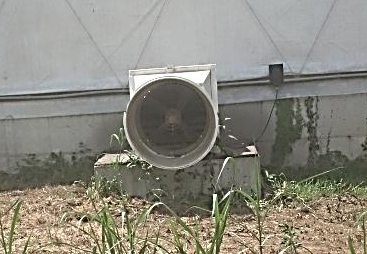Increasing propane prices are impacting pig producer’s bottom line
With winter weather continuing to hang around, pork producers are looking for ways to save fuel and reduce their overall energy bill.
The U.S. Energy Information Administration reports propane prices gradually increased from under $2.40 a gallon in early October, 2013 to almost $3.00 per gallon by mid-January, 2014. By the end of January prices had spiked to $4.00 per gallon, rates that that many in the U.S. had not seen before. According to the National Propane Gas Association today’s high prices were influenced by a series of 2013 events.
- Increasing exports are impacting supply. In 2013 20 percent of the U.S. propane was exported, up from 5 percent in 2008.
- The nation’s record setting corn crop was harvested later and at higher moisture requiring more drying fuel than normal.
- A pipe line that normally transports propane into Minnesota has been shut down for repairs forcing propane providers in Minnesota to dip down into Iowa to access the supplies they need, causing a shift in regional supplies.
- An early December storm initiated a winter that has been longer and colder than in the immediate past. According to the Propane Association, thus far the number of heating degree days this winter is 10 percent higher than normal.
While propane stocks are not worrisome they are significantly below last year’s inventory. The Weekly Petroleum Status Report published by the U.S. Energy Information Administration reports the Jan.31, 2014 propane inventory was 44 percent below the 2013 levels and 34 percent below 2012.
With cold winter weather continuing in February, pork producers are looking for ways to save fuel and reduce their overall energy bill. Producers still have the ability to employ some management changes to different areas that may either save on energy cost, increase pig comfort or both.
 Michigan State University Extension recommends producers make sure the barn’s ventilation and heating systems are set to meet the needs for the stage of growth and number of pigs in the barn. Table 1 provides the recommended ventilation rates based on phase of production for cold, mild and hot weather. Check to make sure the needs of the pigs are being met but the room is not being over ventilated. Use the listed cfm in each fan’s manufactures owner’s manual to calculate the cfm being provided then compare the calculated cfm to the recommended needs of the pigs. At times finishing barns will be half filled one week with the remainder of the pigs placed in the barn the following week. During that time span between when the first set of pigs arrive and when the second set of pigs is delivered, the minimum ventilation should be set to meet the needs of the number of pigs currently in the barn, not the number of pigs when the barn is at full capacity.
Michigan State University Extension recommends producers make sure the barn’s ventilation and heating systems are set to meet the needs for the stage of growth and number of pigs in the barn. Table 1 provides the recommended ventilation rates based on phase of production for cold, mild and hot weather. Check to make sure the needs of the pigs are being met but the room is not being over ventilated. Use the listed cfm in each fan’s manufactures owner’s manual to calculate the cfm being provided then compare the calculated cfm to the recommended needs of the pigs. At times finishing barns will be half filled one week with the remainder of the pigs placed in the barn the following week. During that time span between when the first set of pigs arrive and when the second set of pigs is delivered, the minimum ventilation should be set to meet the needs of the number of pigs currently in the barn, not the number of pigs when the barn is at full capacity.

Exhaust fans that use the barn’s manure pump out ports as fan transitions should be securely mounted and checked for gaps and air leaks. Air leaking around these fans may cause cold drafts on animals, inefficient ventilation systems as incoming air by-passes the normal air inlets and excessive barn cooling. The fan in the picture on the right is securely mounted and tight fitting.
 When the barn is in heater mode, as the room warms the heater will turn off but the temperature in room will continue to rise. This continued rise in temperature is referred to as heater drift. If the offset between the heater off setting and set point is to narrow the rise in temperature caused by heater drift will exceed the set point. The ventilation controller responses by increasing the speed of the variable speed fans and works to exhaust the air that had just previously been warmed. For most controllers the recommended offset between heater off and set point is 2 degrees Fahrenheit. The diagram on the left illustrates heater drift exceeding the heater off setting but staying below the room’s set point.
When the barn is in heater mode, as the room warms the heater will turn off but the temperature in room will continue to rise. This continued rise in temperature is referred to as heater drift. If the offset between the heater off setting and set point is to narrow the rise in temperature caused by heater drift will exceed the set point. The ventilation controller responses by increasing the speed of the variable speed fans and works to exhaust the air that had just previously been warmed. For most controllers the recommended offset between heater off and set point is 2 degrees Fahrenheit. The diagram on the left illustrates heater drift exceeding the heater off setting but staying below the room’s set point.
Variable speed fans should be set no lower than 50 percent voltage. Setting the fan below 50 percent at the very least may result in less ventilation (cfm) than anticipated and at the worst allow the fan motor to stall out.
On tunnel ventilated barns the top of the curtain should fit tight with no air gap. On barns that are 100 percent naturally ventilated the gap at the top of the curtain may be the barn’s minimum ventilation and should be manually adjusted depending on the needs of the pigs in the barn.
As suggested earlier checking each room’s ventilation and heater setting may help control energy expenses and should at the very least increase pig comfort while providing some savings on heating bills this winter.



 Print
Print Email
Email




